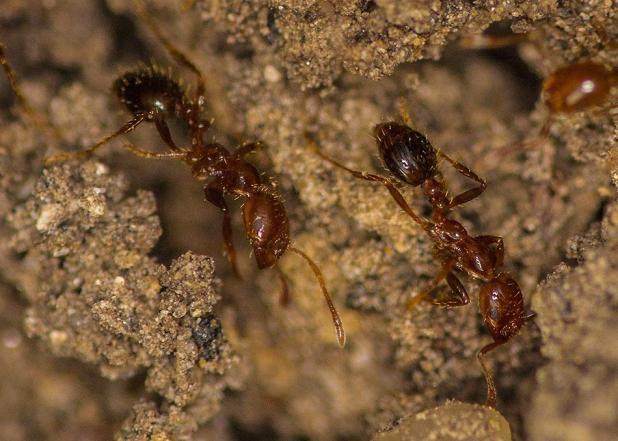
Fire ants can both sting and bite. Stings inject venom.
—LSU AgCenter/Claudia Husseneder
Get It Growing: Get ahead of fire ants
Fire ants can be a formidable foe in the garden and landscape. They come with a one-two punch for sure. Did you know that fire ants both bite and sting? But the pain comes primarily from their sting containing venom.
A few interesting facts about fire ants: When a mound is disturbed, ants can swarm their invader and start stinging within 10 to 20 seconds. It is the sterile female worker ants that rush to the surface and climb grass blades, sticks and legs of people or animals that are standing on or near to the nest. They begin to bite, sting and inject venom within 10 to 20 seconds.
Stings can cause localized sterile blisters. And if you are allergic or are heavily bitten, they can be a dangerous medical issue.
Fire ant colonies can be as large as 200,000 ants. They are typically comprise female worker ants and one queen, who is responsible for laying 1,500 to 1,600 eggs a day. The queen can live up to seven years, and she never leaves the nest. Workers create underground tunnels that can extend up to 25 feet away from the mound, and it can take several months for a colony to grow a mound that is actually large enough to be seen.
Fire ants were accidentally brought to the U.S. on a cargo boat from South America, and since then, they have spread aggressively in the South and Southeast. Colder northern soil temperatures make it hard for ants to survive winter there.
Fire ants prey on flea larvae, chinch bugs, cockroach eggs, ticks and other pests, making it a hard decision — us or them? They are also attracted to electrical fields, such as air conditioners, water pumps, equipment and electrical devices.
As the weather warms in spring and the ground begins to dry, mounds are more evident as the ants emerge from dormancy and begin their tyranny.
They can be a nuisance, but a variety of products and methods are at your disposal to help control ant populations. Be persistent and use the correct application for best control. Before using any product, always read the label carefully before you purchase it, and make sure you understand the directions.
Retired AgCenter entomologist Dale Pollet recommends using baits. They should be applied starting now in April and again in October for best control. He says it is crucial that they go down on dry ground 24 to 48 hours before expected rain. Baits are safe for use around pets. But if you have chickens, he recommends putting them up for a few days when applying ant bait. Never apply baits near water systems such as ponds and lakes.
Baits consist of an insecticide combined with a food material that the fire ants will eat and bring to the colony to feed to other ants, including the queen. You can apply bait to individual mounds, but it is best to broadcast it over an entire yard at a rate of 1 to 2 pounds per acre.
For small lots, one-half to three-quarters of a pound is sufficient to treat the entire yard. Even more effective than treating one yard, coordinate distribution with surrounding neighbors for best control. Work with your homeowners association or organize an entire neighborhood treatment, and the results are even better.
Some additional options are dusts that typically contain acephate. Apply the dust to the mound, and it will pass through the entire colony killing them within days.
Mound drenches are liquid concentrates mixed with water to create 1 gallon of diluted mixture and applied to the top of the mound. Be sure to do this when the ground is dry and not saturated with water, or you will not get movement of the insecticide to penetrate underground to the entire nest. The ants should die within a day.
Granules are another treatment, usually used to treat mounds by sprinkling the recommended amount on the top of the mound without disturbing it. Check the label to see if should be watered in. Make sure to completely penetrate the mound, or ants will move to a different site through underground foraging tunnels to avoid the insecticide.
For organic options, use insecticides with boric acid, pyrethrin, rotenone or diatomaceous earth labeled for ant control. Boiling hot water is also effective but hardly ever penetrates the entire mound, only eliminating part of the mound. You will have to reapply boiling water in the following days to eliminate the remainder of the mound.
Let’s dispel some myths: Grits do not work to kill ants. In fact, you will just be feeding them because much like we Southerners, ants love them. Also, a shovel from one mound on top of another to make ant colonies fight to the death is an exciting notion (imagine tiny ants in gladiator suits). But again, there is no merit to this myth. In fact, colonies can spread up to 25 feet, and the others are likely members of the same colony. So avoid the colony reunion, and save your back from this myth.
The AgCenter offers several free publications, including the “Louisiana Home Lawn Series: Red Imported Fire Ant” available online at https://bit.ly/lafireants and a complete guide “Managing Imported Fire Ants in Urban Areas” available online at https://bit.ly/urbanfireants.
